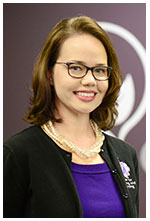By Megan Sharp Weatherly '04
Interim Director, Center for Teaching and Learning
 We didn’t panic. There’s no doubt the rhythms of our classes, departments, community and lives were disrupted when COVID-19 necessitated a transition to remote instruction, but SFA faculty and staff did not divert from our mission of engaging students in a learner-centered environment.
We didn’t panic. There’s no doubt the rhythms of our classes, departments, community and lives were disrupted when COVID-19 necessitated a transition to remote instruction, but SFA faculty and staff did not divert from our mission of engaging students in a learner-centered environment.
I have the privilege of leading SFA’s Center for Teaching and Learning, an energetic team of seven whose mission is to support, strengthen and promote teaching effectiveness and student learning. As plans for closing campus began to form during spring break, the CTL team jumped into action and created the Keep Teaching website, which provided SFA faculty members with resources to help them navigate their transition to remote teaching.
As soon as the transition was formally announced, SFA’s faculty members got to work, accessing available resources, recording lectures, crafting remote learning experiences for students, and sharing ideas and experiences among themselves.
Within a week, 700-plus faculty members transitioned more than 2,200 SFA courses from face-to-face to remote learning.
Fortunately, the technological infrastructure needed for remote instruction was largely already in place. SFA has offered online courses for more than 20 years, and adoption of our learning management system, Brightspace by D2L, is widespread. Perhaps most importantly, we already had Zoom, a stable videoconferencing solution. Though we’d had an institutional license with Zoom for more than two years and used it to broadcast campus meetings, almost every employee got a crash course in the details of its use in mid-March.
The most difficult part of the transition wasn’t our campus community having to learn new technologies but instead the speed and scale of the necessary changes. In only a few days, faculty members had to determine the best plan of action for transitioning each of their courses, communicate that plan to their students and then execute it. To put this in perspective, faculty members often spend a semester or more developing one online course. Now, they were faced with transitioning three or four courses to some blend of online and Zoom instruction.
Our faculty members responded with verve and creativity. Teaching is both an art and a science; it requires not only information dissemination but also constant experimentation and the creative evolution of assessments and experiences. Within days of the start of remote instruction, CTL staff members began hearing about the exceptional ways faculty members were embracing the unique teaching situation COVID-19 created. For example, education students held live, online lessons and activities for local elementary students; culinary students planned and prepared meals in their own homes; business students crafted interactive data dashboards tracking COVID-19 cases; and agriculture students remotely monitored expectant mares at the Equine Center. From necessity came remarkable innovation.
Our provost, Dr. Steve Bullard, is fond of the Alvin Toffler quote, “The illiterate of the 21st century will not be those who cannot read and write, but those who cannot learn, unlearn and relearn.” I think the ways in which our faculty members and students adapted during spring 2020 revealed the truth in that statement. We had to learn new technologies, teaching methods and ways of interacting with students and colleagues when we couldn’t be in the same room. We had to unlearn a few things, as well, including stepping out of the routine ways we approached teaching in the past. We had to relearn technologies we may have used only a handful of times but now rely on daily. Our biggest lesson was the need to be flexible and nimble — a lesson that surely will serve us well in the months and years to come.

 Axe ’Em, Jacks!
Axe ’Em, Jacks!